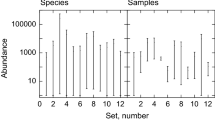Summary
Comparison of co-occurrences between species on a group of islands with those expected from a randombased null model could provide evidence on community structure. However, it is difficult to decide on the appropriate null model. Gilpin and Diamond proposed a model and a test for departure from it, but this test is shown to indicate significant structure even when applied to a matrix of random numbers. An alternative method is suggested, using the distribution of Gilpin and Diamond's deviation as test statistic, but determining the expected distribution by Monto Carlo simulation, and using many such simulations as a randomisation test of significance. The null model used accepts the observed totals of occurrences for islands and species; it therefore offers a somewhat conservative test. Applied to the Vanuatu bird data that Gilpin and Diamond used, significant departure from a null model is seen, but with an excess of extreme negative associations, the opposite result from that given by Gilpin and Diamond's method. It is not possible to tell whether the negative associations are due to autecology, biogeography, or to interactions between species.
Similar content being viewed by others
References
Connor EF, Simberloff D (1979) The assembly of species communities: chance or competition. Ecology 60:1132–1140
Connor EF, Simberloff D (1983) Inter-specific competition and species co-occurrence patterns on islands: null models and the evaluation of evidence. Oikos 41:455–465
Connor EF, Simberloff D (1984) Neutral, models of species co-occurrence patterns. In: Strong DR Jr, Simberloff D, Abele LG, Thistle AB (eds) Ecological communities: conceptual issues and the evidence. Princeton Univ. Press. Princeton, New Jersey, pp 316–331, 341–343
Diamond JM (1975) Assembly of species communities. In: Cody ML, Diamond JM (eds) Ecology and evolution of communities. Harvard Univ. Press Cambridge, pp 342–444
Diamond JM, Gilpin ME (1982) Examination of the “null” model of Connor and Simberloff for species co-occurrence on islands. Oecologia (Berlin) 52:64–74
Edgington ES (1980) Randomization Tests Marcel Dekker, New York
Gilpin ME, Diamond JM (1982) Factors contributing to non-randomness in species co-occurrences on islands. Oecologia (Berlin) 52:75–84
Gilpin ME, Diamond JM (1984) Are species co-occurrences on islands non-random, and are null hypotheses useful in community ecology? In: Strong DR (eds) Ecological communities: conceptual issues and the evidence. Princeton Univ. Press Princeton, New Jersey, pp 297–315, 332–341
Wright SJ, Biehl CC (1982) Island biogeographic distributions: testing for random, regular and aggregated patterns of species occurrence. Am Nat 119:345–357
Author information
Authors and Affiliations
Rights and permissions
About this article
Cite this article
Wilson, J.B. Methods for detecting non-randomness in species co-occurrences: a contribution. Oecologia 73, 579–582 (1987). https://doi.org/10.1007/BF00379419
Received:
Issue Date:
DOI: https://doi.org/10.1007/BF00379419




